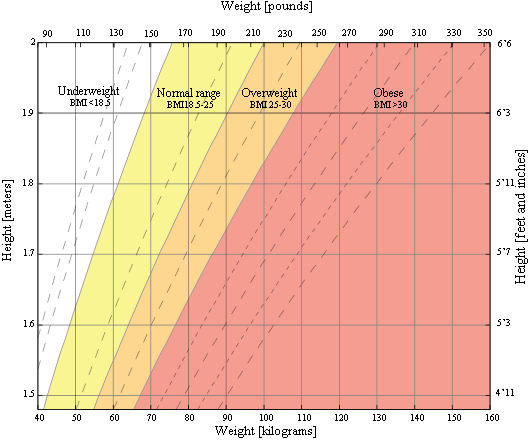📊 BMI Categories for Adults
The World Health Organization (WHO) defines BMI classifications for adults, applicable to both men and women aged 20 and older.
| Category | BMI Range (kg/m2) |
| Severe Thinness | < 16 |
| Moderate Thinness | 16 - 17 |
| Mild Thinness | 17 - 18.5 |
| Normal | 18.5 - 25 |
| Overweight | 25 - 30 |
| Obese Class I | 30 - 35 |
| Obese Class II | 35 - 40 |
| Obese Class III | > 40 |
📈 BMI Chart for Adults
The following graph represents BMI categories based on WHO data, with dashed lines indicating subcategories.

👶 BMI for Children and Teens (Age 2–20)
The Centers for Disease Control and Prevention (CDC) provides BMI classifications for children and adolescents.
| Category | Percentile Range |
| Underweight | <5% |
| Healthy weight | 5% - 85% |
| At risk of overweight | 85% - 95% |
| Overweight | >95% |
⚠️ Health Risks of Overweight
Excess weight increases the risk of serious health conditions, including:
- 💓 High blood pressure
- 🩸 Elevated LDL ("bad") cholesterol, low HDL ("good") cholesterol, and high triglycerides
- 🍩 Type 2 diabetes
- ❤️ Heart disease and stroke
- 🫃 Gallbladder disease
- 🦴 Osteoarthritis
- 😴 Sleep apnea
- 🎗️ Certain cancers (e.g., breast, colon, kidney)
- 🧠 Reduced quality of life and mental health issues
⚠️ Health Risks of Being Underweight
Being underweight can lead to health problems such as:
- 🥦 Malnutrition and vitamin deficiencies
- 🦴 Osteoporosis and weakened immune function
- 🧒 Developmental issues in children and teens
- 👩🍼 Reproductive challenges in women
🧮 Limitations of BMI
BMI does not account for muscle mass, bone density, or fat distribution, making it an imperfect measure. For example:
- 🏋️ Athletes may have high BMI due to muscle mass, not excess fat.
- 👵 Older adults may have higher body fat despite normal BMI.
- 👩 Women generally have higher body fat percentages than men at the same BMI.
📐 BMI Formula
The formulas for BMI calculation in different units are:
| 📏 US Units: |
| BMI = (703 × weight in lbs) / (height in inches)2 |
| 📏 Metric Units: |
| BMI = weight (kg) / height (m)2 |
➗ BMI Prime
BMI Prime is the ratio of a person's BMI to the upper limit of the normal BMI range (typically 25 kg/m2):
BMI Prime = BMI / 25
Categories based on BMI Prime:
| Category | BMI Prime |
| Severe Thinness | < 0.64 |
| Normal | 0.74 - 1 |
| Overweight | 1 - 1.2 |
| Obese | > 1.2 |
📏 Ponderal Index
The Ponderal Index (PI) is an alternative to BMI, more accurate for very tall or short individuals. The formula is:
PI = weight (kg) / height (m)3
Unlike BMI, which squares height, PI cubes it, making it a better indicator of body composition for extreme heights.
✅ Conclusion: While BMI is a useful screening tool, it should be considered alongside other health assessments. Always consult a healthcare professional for personalized health guidance.


